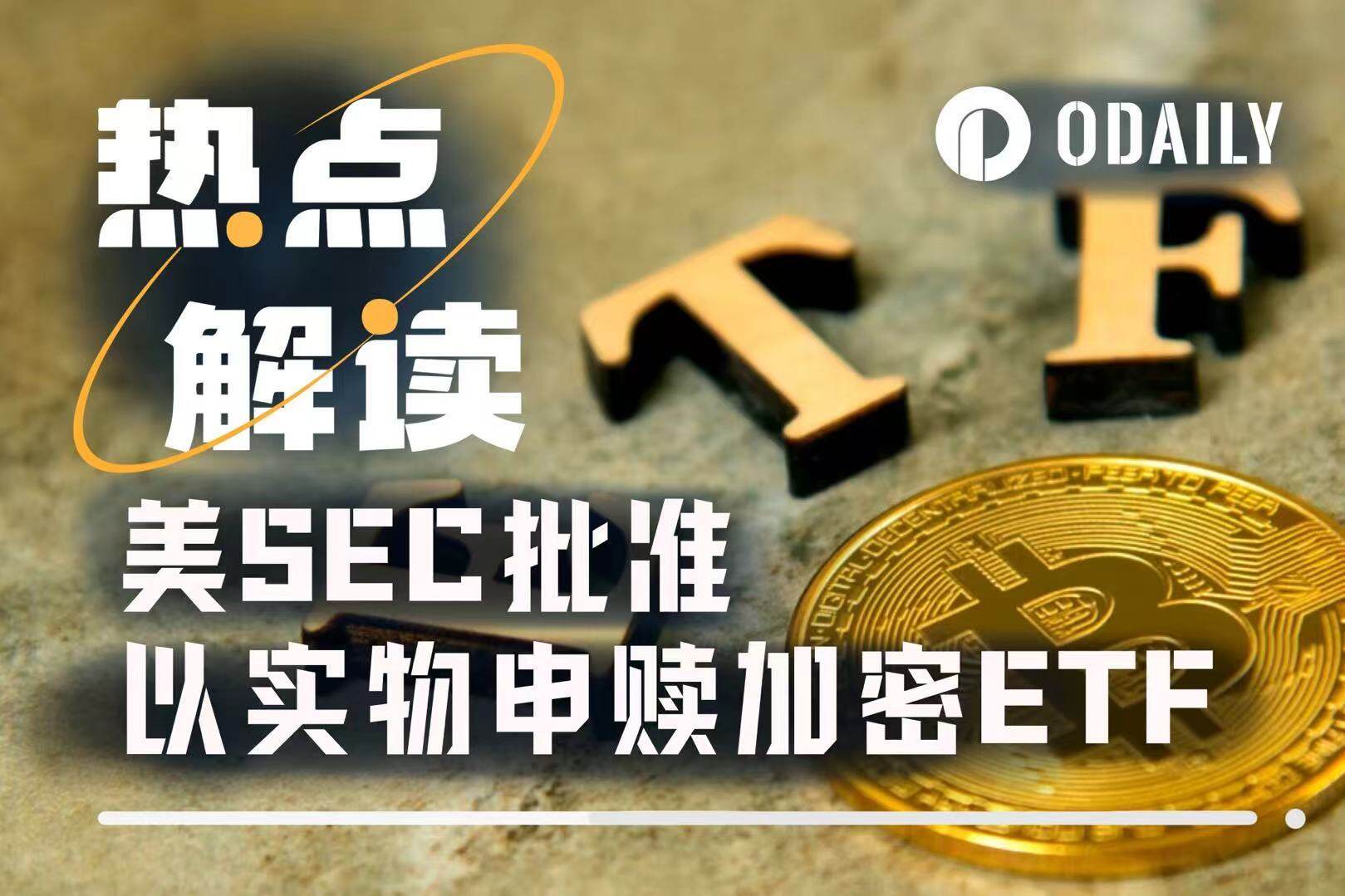The US SEC gives the green light, and crypto ETFs enter the commodity era
- 核心观点:美SEC允许实物形式创建赎回加密ETF。
- 关键要素:
- 降低AP成本,提升市场效率。
- 减少赎回对加密市场价格冲击。
- 为套利者提供更高效机制。
- 市场影响:推动机构资金长期配置加密资产。
- 时效性标注:长期影响。
Original | Odaily Planet Daily ( @OdailyChina )
By Golem ( @web3_golem )
On July 29th, the US SEC officially allowed Authorized Participants (APs) to create and redeem crypto ETFs in physical form . This means that Bitcoin and Ethereum ETFs will be aligned with other commodity ETFs (such as oil and gold) and will allow for the creation and redemption of ETF shares in physical form. Previously, Bitcoin and Ethereum ETFs were limited to cash creation and redemption.
Cash vs. Physical
So, how does creating and redeeming a crypto ETF in cash differ from creating and redeeming a crypto ETF in physical form?
Cash form: AP and ETF issuer settle in cash
The previous process for creating and redeeming ETF shares in cash for Bitcoin and Ethereum ETFs is briefly as follows:
- ETF Creation Process
ETF issuers publish a basket of cash amounts daily, representing the total cash required to create one “creation unit”;
The Authorized Participant (AP) delivers cash to the ETF issuer;
After receiving the cash, the ETF issuer purchases the corresponding amount of crypto assets in the market and adds them to the ETF custody pool;
The ETF issuer finally issues the corresponding number of ETF shares to the AP.
- ETF Redemption Process
When the ETF price in the market is lower than the net asset value (NAV) on that day, AP will buy the corresponding number of ETF shares in the secondary market;
The AP returns these shares to the ETF issuer;
The ETF issuer sells the corresponding amount of Bitcoin/Ethereum based on the redemption shares and exchanges it for cash in the spot market;
The issuer then returns this cash to the AP to complete the redemption.
Physical form: AP and ETF issuer settle in “physical” (i.e. currency)
- ETF Creation Process
The ETF issuer specifies a "creation unit," which is usually tens of thousands of ETF shares. The net asset value (NAV) corresponding to this unit is the total amount of crypto assets that the AP needs to deliver;
The AP “packages” the specified basket of crypto assets and transfers it to a designated custody account through a secure custody and transfer agreement agreed in advance with the ETF issuer;
After the issuer verifies that the received assets are correct, it will deliver the corresponding number of ETF shares to the AP.
- ETF Redemption Process
When the market price of an ETF on an exchange is lower than its NAV, the AP will purchase at least one creation unit of ETF shares in the secondary market;
AP returns this batch of ETF shares to the issuer and applies for "in-kind redemption";
After confirming receipt of the ETF shares, the issuer will transfer the equivalent value of crypto assets (based on the latest NAV and holding weights) from the custody account back to the AP;
AP recovers the corresponding encrypted assets.
What's the point?
As can be seen above, allowing the creation and redemption of crypto ETFs in physical form does not mean that ordinary investors can directly exchange their ETF shares for crypto assets. Instead, it means that the settlement between authorized participants (APs) and ETF issuers changes from cash to "physical crypto." This not only means that existing crypto ETF assets (such as Bitcoin and Ethereum) have the same regulatory status as commodities such as gold and oil, but also brings the following benefits:
Reduce AP costs and improve market efficiency
In cash form, ETF issuers need to use the cash delivered by AP to purchase crypto assets. Due to the rapidly changing crypto market, this process may increase transaction fees and slippage.
In physical form, APs directly deliver crypto assets to ETF issuers, effectively avoiding transaction fees and slippage, reducing costs. Furthermore, by reducing the delays and costs associated with spot trading, the integration process with ETF issuers is streamlined, and the ETF's secondary market price is more closely aligned with its NAV, improving market efficiency.
In addition, in cash form, cash transactions may trigger capital gains distributions at the fund level, but transfers in kind generally do not constitute capital gains at the fund level, further reducing the tax cost of AP.
Reduce the impact of ETF redemptions on crypto market prices
In cash form, ETF redemption means that ETF issuers have to passively sell crypto assets in the market in exchange for cash, which may trigger a "liquidity stampede."
However, in physical form, ETF redemptions simply represent the ETF issuer returning the crypto assets to the AP, without any market transactions. Upon receiving Bitcoin or Ethereum, the AP's decision about whether to sell immediately, how to sell, and to whom depends entirely on its own strategy. Compared to the one-time, large-scale liquidation of ETF funds, the AP's actions are more decentralized, market-oriented, and flexible.
Providing a more efficient mechanism for ETF arbitrageurs
The foundation of ETF market arbitrage lies in the "primary market arbitrage" mechanism, whereby APs create and redeem positions using the spread between the ETF price and NAV. In cash transactions, due to the time lag between spot trading and ETF creation and redemption, market price fluctuations can lead to arbitrage failures or increased costs. In physical transactions, APs can directly open and close positions with crypto assets, enabling more efficient, scalable, and rapid arbitrage.
At the same time, a more efficient arbitrage mechanism can also help the price of crypto ETFs closely track their net asset value, thereby improving liquidity.
Crypto assets are integrated into the deep structure of mainstream finance
International commodity ETFs, such as gold, silver, and crude oil ETFs, are mostly created and redeemed in physical form. Crypto ETFs now use the same mechanism, which means that crypto assets are being incorporated into the deep structure of the mainstream financial product system, promoting global institutions to allocate crypto assets.
The introduction of the physical mechanism provides a structural buffer for larger-scale capital inflows in the future, which is conducive to the entry of longer-term funds such as institutions, pensions, and hedge funds .



